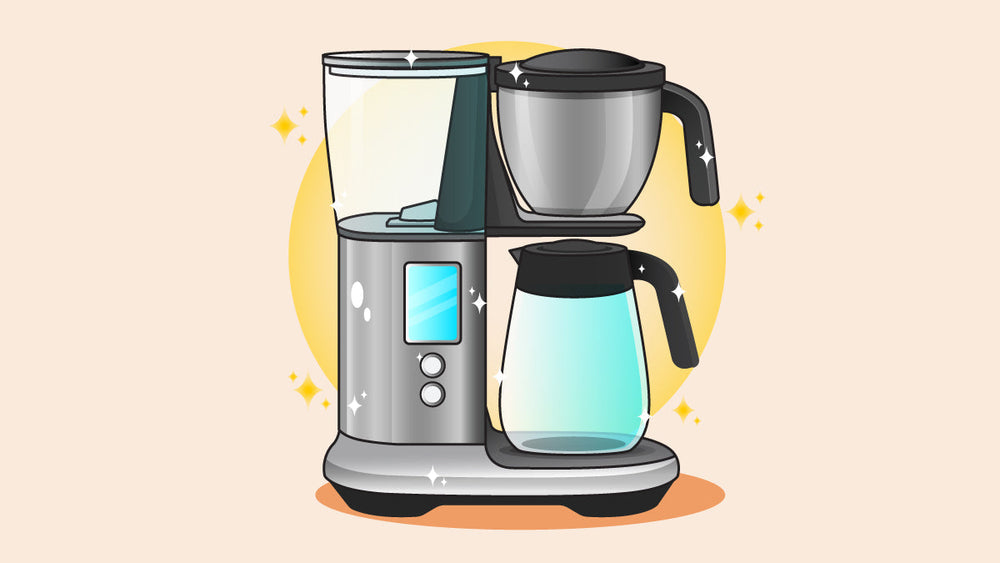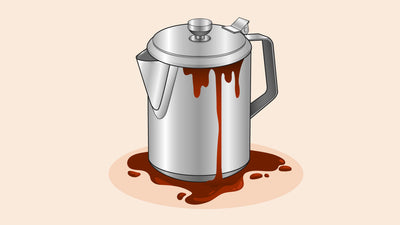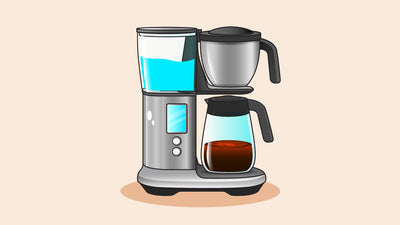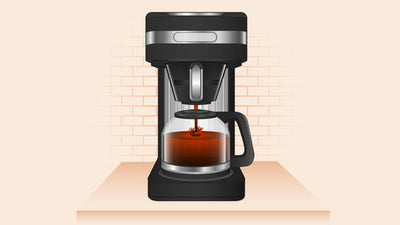Cleaning your coffee maker probably isn’t at the top of your to-do list, but it’s easier — and more important — than you might think.
To clean your coffee maker, run a brew cycle with a 50/50 mixture of vinegar and water. Follow that up with 2 brew cycles with just water and you’ve got a clean coffee machine that produces excellent-tasting coffee again!
In this post, we’ll go over how to clean different coffee makers and dive into why it’s so important to keep them clean.
How to Clean & Descale a Coffee Maker
These steps work for cleaning most drip coffee makers. How often you need to clean and descale your coffee maker depends on how hard your water is and how frequently you use your machine.
If you have hard water and/or use your machine daily, you should clean and descale it once every three months. If you have soft water and/or only drink coffee occasionally, you should clean and descale it once every six months.
Read More: 105 Coffee Facts
Descaling a Coffee Maker With Vinegar: Step-by-Step
Here’s what you’ll need to do the internal cleaning.
What You’ll Need
- Coffee maker
- White distilled vinegar
- Coffee filters
- Cleaning cloth
Directions
- Fill the reservoir with a 50:50 ratio of water and white distilled vinegar.
- Place a filter in the basket and run a brew cycle.
- Halfway through, turn the coffee maker off and leave the solution to soak for 30 minutes.
- Turn the coffee maker on and complete the brewing cycle.
- Discard the paper filter and pour the vinegar solution away.
- Fill the reservoir with water and place a paper filter in the basket.
- Turn the coffee maker on and let it run a full brew cycle.
- Discard the filter and water.
- Repeat steps five and six to run a second cycle. Discard the filter and water each time the cycle is done.
- Wash the reservoir, filter basket, carafe, and showerhead by hand in warm soapy water and leave to dry.
- Wipe down the outside of your coffee maker with a damp cloth, then reassemble.
It looks like a lot of steps, but cleaning your coffee maker should only take 60 minutes. Keep in mind that half of this time involves leaving the vinegar solution to soak in the coffee maker.
Related: Mastering Drip Coffee: Expert Tips & Tricks for Brewing Like a Pro
Cleaning a Coffee Maker: Tips for Daily Maintenance

To keep your coffee maker looking its best, wash the reservoir, filter basket, carafe, and showerhead in warm, soapy water at the end of each day.
It sounds like a chore, but it will keep your machine looking new and your coffee tasting great.
Alternative Cleaning Products
Here are some effective and economical ways to clean your coffee maker:
- Lemon juice — Use a 50:50 ratio of water to lemon juice to clean your coffee maker.
- Dishwasher — Check your coffee maker’s manual to see if it’s dishwasher safe. If it is, you can place the reservoir, filter basket, carafe, and showerhead in your dishwasher and let it do all the hard work.
- Baking soda — If your carafe is badly stained, make a paste with baking soda and water. Scrub it onto the stains, and they'll soon disappear.
- Dishwasher tablet — Dishwasher tablets work great at cleaning a stained carafe, even if you don’t have a dishwasher. Place the tablet in the carafe with hot water and leave for 30 minutes before scrubbing with a sponge.
- Denture tablets — They remove stains on carafes as well as dentures! Place two tablets in the carafe with hot water and leave to soak for 15 minutes. Scrub with a sponge and the stains will vanish.
Why You Should Clean Your Coffee Maker

If your coffee maker has been playing up recently, there’s a good chance all it needs is a cleaning to bring it back to its former glory.
If your machine isn’t cleaned regularly, it can cause the following problems:
- Oily sludge and mineral buildup
- Longer-than-usual extraction time
- Strange noises during brewing
- Inconsistent performance
- Bitter coffee
While the above are all serious issues, it’s the hidden bacteria and germs that pose an even larger problem.
A National Sanitation Foundation (NSF) International study found that coffee makers rank in fifth place as having the most germs in your home. Half of the reservoirs they tested contained mold and yeast.
These harmful organisms may cause allergic reactions and even infections, which can make you seriously unwell. Without proper cleaning, the coffee maker you use each morning could be making you sick.
But it’s not all bad news. To keep your coffee maker free from unsafe yeast and mold, all you have to do is keep it clean.
Read More: Coffee Statistics You Need To Know
How to Keep Your Coffee Maker Clean for Longer
The cleaner you keep your coffee maker, the less time you have to spend cleaning it!
Follow these tips to keep your coffee maker cleaner for longer:
- Only brew with demineralized water.
- Never leave used, wet coffee grounds in the coffee maker.
- Always read the manufacturer’s recommendations and follow them.
- Clean your coffee maker once every month if you drink coffee daily or once every three months if you drink coffee occasionally.
FAQs: Cleaning Coffee Makers
1. Is there a difference between descaling and cleaning?
Yes, there is a difference, and you need to be doing both to keep your coffee tasting the best it can.
Descaling involves removing mineral buildup to extend the life of your coffee maker and improve its efficiency. Cleaning removes coffee bean oil residue, which can become rancid over time and make your coffee taste awful.
Some machines though, like Keurig coffee maker, Cuisinart machine or Ninja coffee maker, may have unique parts or special cleaning instructions, so always refer to your user manual or a brand-specific guide.
White distilled vinegar conveniently descales and cleans your coffee maker at the same time.
Read More: What Does Vietnamese Coffee Taste Like?
2. Does vinegar really clean a coffee maker?

Yes, using white distilled vinegar is the best way to clean a coffee maker. Its acidic quality means it can quickly and easily remove coffee bean oil residue and calcium deposits from the inside of your machine.
Vinegar also acts as a disinfectant, eliminating mold and yeast that can make you sick. If you don’t have white distilled vinegar, a 50:50 ratio of water to lemon juice works, too.
3. Does a professional coffee maker cleaner work better than vinegar?
Not necessarily. It doesn’t matter what you use to clean your coffee maker — as long as you do it regularly.
Professional coffee maker cleaners and vinegar all work the same way. They dissolve the scale that can clog your coffee maker and cause problems. Whatever you use, just make sure you run a brew cycle twice after cleaning to get rid of the unwanted smell and taste.
Coffee maker cleaners are considerably more expensive and difficult to buy than distilled white vinegar. They both achieve similar results, so which one you use is your decision.
4. How often should a coffee machine be cleaned?
You should clean your coffee machine once a month if you use it every day. This is the best way to keep it free from yeast and mold while making sure your coffee tastes great.
If you only drink coffee occasionally, you should clean your machine once every three months. However, if your coffee starts to taste strange or you notice a buildup in the basket or pot, clean it immediately.
5. What happens if you don’t clean your coffee maker?
Your coffee maker can become unusable if you don’t clean it regularly. Coffee residue can cause blockages and clogging that make your coffee maker stop working completely.
If you don’t clean your coffee maker regularly, yeast and mold will begin to build up inside. This can not only cause bitter-tasting coffee, but also allergies and even infections. Keep your coffee maker clean for the best-tasting coffee and to avoid getting sick.
















